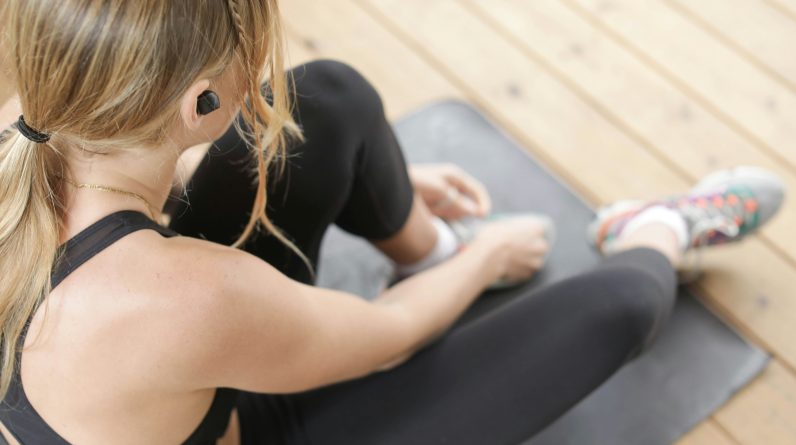
Losing weight doesn’t necessarily require a high-cost gym membership or complicated diet plans. In fact, you can achieve your weight loss goals right from the comfort of your own home. With just a little motivation and discipline, incorporating regular exercise into your daily routine can lead to substantial results. This article will provide you with practical tips and effective exercises that will help you shed those extra pounds and achieve a healthier, fitter version of yourself. Say goodbye to expensive gym equipment and hello to a new, healthier you by learning how to lose weight at home with exercise.

Setting goals
Determining your weight loss goal
Before starting your weight loss journey, it’s important to have a clear and realistic goal in mind. Consider factors such as your current weight, desired weight, and overall health. Consulting a healthcare professional can help you establish a safe and achievable weight loss goal that aligns with your individual needs.
Setting a timeline
Having a timeline for your weight loss goals can help keep you motivated and focused. Break down your overall goal into smaller milestones, such as losing a certain amount of weight each month. Remember to give yourself enough time to reach these milestones, as crash diets or extreme exercise routines can be both ineffective and potentially harmful.
Tracking your progress
Monitoring your progress throughout your weight loss journey is essential for staying on track and making adjustments as needed. Consider using a weight loss tracker, journal, or mobile app to record your weight, measurements, and other relevant data. Regularly reviewing these records will help you identify patterns, track your achievements, and make necessary adjustments to your workout and diet plans.
Creating a workout plan
Choosing the right exercises
When designing your workout plan, it’s important to choose exercises that align with your goals, preferences, and abilities. Incorporating a mix of cardiovascular exercises, strength training, core exercises, flexibility exercises, and HIIT workouts can help you achieve a well-rounded fitness routine. Experiment with different exercises and find the ones that you enjoy and can perform safely.
Determining the frequency and duration
To see meaningful results, consistency is key. Determine how many days per week you can commit to exercise and allocate sufficient time for each session. Aim for at least 150 minutes of moderate-intensity aerobic exercise or 75 minutes of vigorous-intensity exercise per week, as recommended by the American Heart Association. It’s important to listen to your body, gradually increase the duration or intensity of your workouts, and allow for adequate recovery between sessions.
Including a variety of exercises
Adding variety to your workout plan not only helps prevent boredom but also ensures that you target different muscle groups and keep your body challenged. Incorporate a mix of cardiovascular exercises like running, cycling, or swimming, strength training exercises using weights or bodyweight, core exercises such as planks or Russian twists, flexibility exercises like yoga or Pilates, and high-intensity interval training (HIIT) workouts to keep things interesting and maximize your fat-burning potential.
Considering your fitness level
It’s important to consider your current fitness level when designing your workout plan. If you’re new to exercise or have any health concerns, it’s recommended to start with low-impact exercises and gradually progress as your fitness improves. Consulting a fitness professional can help you assess your fitness level and create a tailored plan that meets your unique needs while minimizing the risk of injury.

Cardiovascular exercises
Benefits of cardio workouts
Cardiovascular exercises, also known as cardio or aerobic exercises, are an essential component of any weight loss plan. These exercises increase your heart rate, improve cardiovascular health, and help burn calories. Regular cardio workouts can also reduce the risk of chronic diseases, boost mood, and enhance overall fitness and endurance.
Types of cardiovascular exercises
There are various types of cardio exercises to choose from, depending on your preferences and fitness level. Running, brisk walking, cycling, swimming, dancing, and using cardio machines like treadmills or ellipticals are all great options. Experiment with different activities to find the ones that you enjoy the most, as this will help increase your adherence to your workout routine.
Designing a cardio routine
To design an effective cardio routine, aim for a combination of moderate-intensity and vigorous-intensity exercises. Start with a warm-up to prepare your body, then engage in activities that elevate your heart rate for at least 30 minutes per session. Gradually increase the duration or intensity as your fitness level improves. Remember to listen to your body and adjust the workout to suit your needs and preferences.
Duration and intensity of cardio
The duration and intensity of your cardio workouts will depend on your fitness level and goals. Aim for at least 150 minutes of moderate-intensity cardio or 75 minutes of vigorous-intensity cardio per week, as recommended by the American Heart Association. However, if weight loss is your primary goal, you may need to increase the duration or intensity of your cardio sessions to maximize calorie burn and fat loss.
Strength training exercises
Importance of strength training
Strength training is crucial for weight loss as it helps build lean muscle mass, which increases your metabolic rate and aids in burning calories even at rest. It also promotes bone health, improves overall strength and stability, and enhances your body composition. Adding strength training exercises to your workout routine will help you achieve a toned and sculpted physique.
Different types of strength training
There are various types of strength training exercises to choose from, including weightlifting, resistance band workouts, bodyweight exercises, and machine exercises. Experiment with different exercises to target specific muscle groups and keep your workouts engaging and challenging. It’s recommended to incorporate both compound exercises that work multiple muscle groups simultaneously and isolation exercises that focus on specific muscles.
Targeting different muscle groups
To create a well-rounded strength training routine, it’s important to target different muscle groups throughout the week. This ensures balanced muscle development and helps prevent muscle imbalances and injuries. Focus on exercises that engage your upper body, lower body, and core muscles. Incorporating exercises like squats, lunges, push-ups, rows, and planks can help you achieve a well-proportioned and functional physique.
Designing a strength training routine
When designing your strength training routine, consider your fitness level, goals, and available equipment. Aim for two or more strength training sessions per week, allowing for at least 48 hours of rest between working the same muscle group. Start with a warm-up, perform two to three sets of each exercise, and gradually increase the weight or resistance as your strength improves. It’s important to prioritize proper form and technique to maximize effectiveness and minimize the risk of injury.
Using weights or bodyweight exercises
Strength training exercises can be performed using weights, resistance bands, or simply your bodyweight. Whether you prefer the versatility of free weights, the convenience of resistance bands, or the simplicity of bodyweight exercises, it’s important to choose the option that aligns with your goals and resources. Experiment with different equipment and workout styles to find what works best for you.
Progressive overload
To continue making progress and challenging your muscles, it’s essential to incorporate progressive overload into your strength training routine. Progressive overload involves gradually increasing the intensity, volume, or complexity of your exercises over time. This can be achieved by adding more weight, performing additional repetitions or sets, reducing rest periods, or incorporating more challenging variations of exercises. Gradually introducing these advancements will keep your body adapting and prevent plateaus in your progress.

Core exercises
Understanding the importance of core strength
Core strength is more than just having visible abdominal muscles. A strong core is essential for stability, balance, and proper posture. It supports and protects your spine, enhances athletic performance, and helps prevent injuries. Incorporating specific core exercises into your workout routine can help you develop a strong and functional core.
Different types of core exercises
Core exercises can be categorized into stabilization exercises and dynamic exercises. Stabilization exercises, such as planks and bird dogs, focus on holding a position to engage and strengthen the deep core muscles. Dynamic exercises, like Russian twists and bicycle crunches, involve movement and target the superficial abdominal muscles. Incorporating a combination of stabilization and dynamic exercises will ensure comprehensive core development.
Designing a core workout routine
When designing your core workout routine, aim for a mix of stabilization and dynamic exercises that target different aspects of core strength. Include exercises that work your rectus abdominis, obliques, transverse abdominis, and lower back muscles. Start with a warm-up, perform two to three sets of each exercise, and gradually increase the duration or intensity as your core strength improves. Remember to prioritize proper form and breathing throughout the exercises.
Incorporating stability exercises
Alongside core exercises, incorporating stability exercises can further enhance your core strength and overall functional fitness. Stability exercises challenge your balance and coordination, engaging not only your core muscles but also your joints and stabilizer muscles. Exercises like single-leg balances, stability ball exercises, and yoga poses are great options to introduce into your routine. Start with simple stability exercises and progressively advance to more challenging variations as your stability improves.
Flexibility exercises
Benefits of flexibility training
Flexibility training is often overlooked but is an essential component of a well-rounded fitness routine. Flexibility exercises improve joint mobility, reduce muscle stiffness, enhance athletic performance, and decrease the risk of injuries. Regular flexibility training can also help alleviate muscle tension, improve posture, and increase relaxation.
Different types of flexibility exercises
There are various types of flexibility exercises to choose from, including static stretching, dynamic stretching, and proprioceptive neuromuscular facilitation (PNF) stretching. Static stretching involves holding a stretch for a specific duration, while dynamic stretching involves controlled movements that mimic functional activities. PNF stretching involves combining contracting and relaxing muscles to achieve greater flexibility. Experiment with different stretching techniques and find the ones that feel most effective and comfortable for your body.
Including stretching in your routine
To incorporate flexibility exercises into your routine, set aside dedicated time before or after your workouts. Aim for at least three to four days per week of stretching, focusing on all major muscle groups. Remember to warm up your muscles with light cardio exercises before stretching to increase blood flow and prevent injuries. Hold each stretch for 15-30 seconds, avoiding bouncing or jerking movements. Gradually increase the stretch without causing discomfort or pain.

High-intensity interval training (HIIT)
Exploring the benefits of HIIT
High-intensity interval training (HIIT) is a time-efficient workout method that involves alternating periods of intense exercise with short recovery periods. HIIT workouts have been shown to boost metabolism, burn calories, and improve cardiovascular fitness. They also require little to no equipment, making them suitable for home workouts. Incorporating HIIT into your routine can help you maximize calorie burn, increase endurance, and break through plateaus.
Designing a HIIT routine
When designing your HIIT routine, choose exercises that target different muscle groups and provide a full-body workout. Incorporate compound movements like burpees, squat jumps, mountain climbers, or kettlebell swings to engage multiple muscles simultaneously. Start with a warm-up, perform each exercise at maximum effort for 20-30 seconds, followed by a recovery period of 10-15 seconds. Repeat this circuit for a total of 3-5 rounds, gradually increasing the duration or intensity as your fitness level improves.
Choosing the right exercises
Select exercises that you can perform safely and effectively. Consider your fitness level and any potential limitations or injuries. Modify the exercises to your needs, using variations or alternative movements if necessary. It’s important to choose exercises that challenge you without compromising your form or risking injury. Consult a fitness professional if you’re unsure about the suitability of certain exercises for your specific needs.
Interval duration and intensity
The duration and intensity of your intervals will depend on your fitness level and goals. As a general guideline, aim for high-intensity intervals that push you to your maximum effort, followed by shorter recovery periods to allow for partial recovery. Beginners may start with 20-30 seconds of high-intensity exercise and 10-15 seconds of rest, gradually increasing the intensity or duration as their fitness improves. Push yourself, but always listen to your body and adjust the intensity to a level that feels challenging yet manageable.
Safety precautions
As with any form of exercise, it’s important to prioritize safety during HIIT workouts. Start with a thorough warm-up to prepare your body for the intense exercise ahead. Modify exercises or choose alternatives if certain movements cause pain or discomfort. Keep good form throughout the workout, focusing on proper technique rather than just speed. Stay hydrated, wear appropriate shoes and clothing, and listen to your body, taking breaks or reducing the intensity if necessary. If you have any underlying health conditions or concerns, consult a healthcare professional before starting HIIT workouts.
Creating a schedule
Finding time for exercise
Finding time for exercise in your daily routine can be challenging, but it’s crucial for achieving your weight loss goals. Prioritize physical activity by scheduling it into your day, just like any other important task. Identify blocks of time that work best for you, whether it’s early mornings, lunch breaks, or evenings. Choose a time when you feel energized and motivated, and make it a non-negotiable part of your daily routine.
Establishing a routine
Establishing a consistent exercise routine can help you stay committed and maintain momentum in your weight loss journey. Set a schedule that includes specific days and times for your workouts. Consistency will not only make exercise a habit but will also optimize your body’s response to training and help you track your progress more accurately. Stick to your routine as much as possible, but also be flexible and adaptable when unexpected events arise.
Balancing workout days
Balancing your workout days is important to prevent burnout and overtraining while allowing for proper recovery. Plan your workouts to include a mix of intense and moderate-intensity sessions, as well as rest days. Avoid consecutive intense workouts to give your muscles time to repair and rebuild. For example, you might alternate strength training days with cardio or flexibility-focused workouts, allowing for active recovery and minimizing the risk of overuse injuries.
Incorporating rest days
Rest days are an essential part of any exercise routine. They allow your body to repair and adapt to the stress of exercise, reducing the risk of injury and fatigue. Incorporate rest days into your schedule, whether it’s complete rest or engaging in low-impact activities like gentle stretching or leisurely walks. Listen to your body and take additional rest days if needed, especially when feeling overly fatigued or experiencing muscle soreness.
Adapting to changes
Your schedule and routine may need to be adjusted from time to time to accommodate changes in your life. Be flexible and adaptable to these changes while staying committed to your overall goals. If a scheduled workout is not possible, find creative ways to fit in physical activity, such as taking the stairs instead of the elevator, going for short walks during breaks, or incorporating home workouts into your routine. Remember, any form of movement counts towards your progress.
Creating a supportive environment
Eliminating temptations
Creating a supportive environment for weight loss involves eliminating or minimizing tempting foods or activities that may hinder your progress. Remove or limit unhealthy snacks or trigger foods from your home. Stock your pantry and fridge with nutritious foods that align with your goals. Consider avoiding social situations or settings that revolve around unhealthy food choices, at least until you feel more confident in making healthier choices.
Surrounding yourself with support
Having a supportive network can greatly boost your motivation and accountability. Share your weight loss goals with family, friends, or coworkers who will encourage and support you along the way. Consider finding an exercise buddy or joining a fitness community or group to help you stay motivated and accountable. Celebrate your achievements together and lean on them during more challenging times.
Setting realistic expectations
Setting realistic expectations is vital for long-term success and maintaining motivation. Weight loss and fitness improvements don’t happen overnight. Be patient with yourself and recognize that progress takes time. Avoid comparing your journey to others and focus on your own individual progress. Set realistic goals that are attainable and sustainable, ensuring that you allow yourself enough time to reach them in a healthy and balanced manner.
Rewarding yourself
Rewarding yourself for your hard work and milestones achieved can provide additional motivation and a sense of accomplishment. Treat yourself to non-food rewards such as a relaxing spa day, a new workout outfit, or a fun activity you enjoy. Celebrate your achievements and acknowledge the effort you’ve put into your weight loss journey. Rewards can help reinforce positive behaviors, making it easier to stay motivated and dedicated to your goals.
Tracking your food intake
Monitoring your food intake is a valuable tool for weight loss. Consider keeping a food diary or using a mobile app to track your meals, snacks, and beverages. This allows you to be more aware of your eating habits, identify patterns or triggers, and make necessary adjustments to your diet. Focus on portion control, choosing nutrient-dense foods, and incorporating a good balance of macronutrients (carbohydrates, proteins, and fats) to support your overall health and weight loss goals.
Staying motivated
Identifying your motivation
Identifying your personal motivation for losing weight and staying healthy is crucial for long-term success. Reflect on the reasons why you want to make a change and keep them at the forefront of your mind. Whether it’s improving your overall health, boosting self-confidence, or having more energy to keep up with your loved ones, connecting with your motivation will help you stay focused and committed on days when motivation may waver.
Setting short-term goals
Breaking down your long-term goals into smaller, manageable short-term goals can make them more achievable and maintain motivation. Set specific and measurable goals that you can work towards each week or month. Celebrating these milestones along the way will provide a sense of accomplishment and reinforce positive behaviors. Regularly reassess your goals and make adjustments as needed to keep them challenging yet attainable.
Finding enjoyable activities
Finding physical activities that you genuinely enjoy can significantly improve your motivation and adherence to your exercise routine. Experiment with different activities, such as dancing, hiking, swimming, or group classes. Choose activities that make you feel energized and excited to participate. When exercise feels like a fun and enjoyable experience rather than a chore, it becomes easier to stay motivated and consistent.
Getting accountability and support
Accountability and support are essential when it comes to staying motivated. Engage a workout buddy or enlist the help of a personal trainer or coach who can provide guidance, encouragement, and accountability. Consider joining online fitness communities or forums where you can connect with like-minded individuals who are on a similar weight loss journey. Sharing your progress, challenges, and victories with others can boost motivation and provide valuable support.
Tracking your progress
Regularly tracking your progress is a powerful tool for staying motivated. Monitor changes in your weight, measurements, strength, endurance, or overall fitness levels. Take progress photos or keep a journal to record how you feel physically and mentally. Celebrate your achievements, whether they’re big or small, and use them as a reminder of what you’re capable of achieving. Reflecting on your progress can reignite motivation and inspire you to keep pushing forward.







